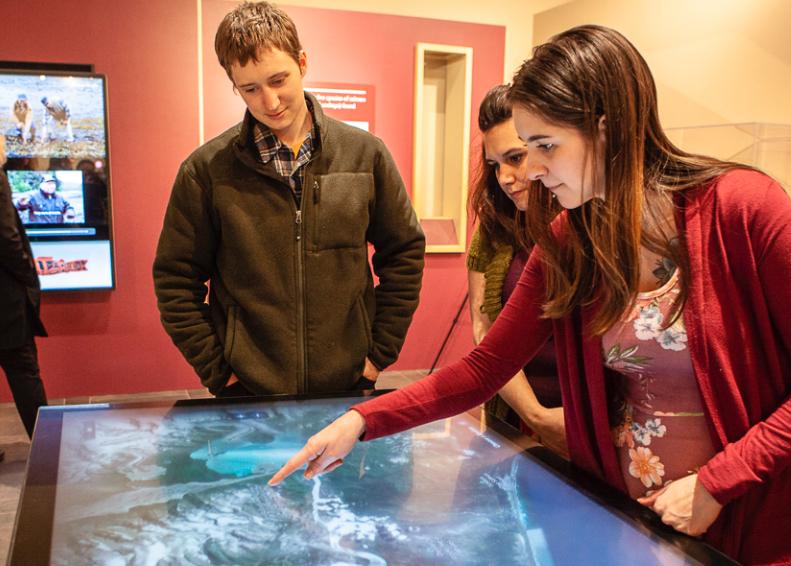Revisiting Touchscreen Interactives in the Time of Coronavirus
Overview
We’ve been in contact with several of our clients who have touchscreen monitors that display our interactive installations in their headquarters, museums, and cultural arts centers. These locations were closed during the spring and early summer of 2020 because of the COVID-19 pandemic. Their staff and visitors were all required to shelter in place and public areas like museums had to be closed. But as the country slowly reopens and these digital displays are powered up again, it’s easy to guess that they won’t have the same appeal as they did before the pandemic began.
People are going to be hesitant to touch surfaces located in public spaces. There seems to be little threat of contracting the coronavirus by touching a hard surface. But, according to the CDC, it’s possible if the hard surface has been in an area where an infected person has coughed or sneezed. People could touch a surface that contains coronavirus and touch their own face, breathing in the virus that’s been transferred.
We are recommending our clients regularly clean and disinfect the touchscreens using the manufacturer’s recommendations. Nothing abrasive should be used, but using EPA approved disinfectants a few times each day will greatly reduce the risks to your visitors. Here are a few common cleaning products from the list of EPA-recommended disinfectants that are safe for touchscreen monitors:
- Clorox Disinfecting Wipes
- Clorox Healthcare Bleach Germicidal Wipes
- Clorox Commercial Solutions Hydrogen Peroxide Cleaner Disinfectant Wipes
- Lonza Disinfectant Wipes
- Lysol Brand Clean & Fresh Multi-Surface Cleaner (20% cleaner solution to water ratio)
- Purell Professional Surface Disinfectant Wipes
- Sani-Cloth Prime Germicidal Disposable Wipes
Another item that will nearly eliminate the chance of transferring coronavirus from a touchscreen monitor to a visitor’s hand is a simple, conductive stylus. The stylus touches the screen instead of the visitor’s finger and works as well on all modern, capacitive touchscreens. Two styluses can be used for pinch and zoom interactions that normally require two fingers to complete. We are experimenting with a very inexpensive stylus that can be disinfected after each visitor is through with it and then safely reused. Our clients can use the stylus as a promotional item by printing their name and logo on it. Then, each visitor could be given their personal stylus when entering the facility and there wouldn’t be a need to disinfect it later.
"One interactive technology that seems well suited to a future where people might be reluctant to touch shared surfaces is Augmented Reality (AR)."
Interacting with a publicly accessible touchscreen should be a safe and comfortable experience. As America begins to spend more time in public gathering places, requiring the use of shared digital devices can potentially stop your visitors from interacting with your content. We think that does not have to happen as long as the screens are cleaned a few times a day and a clean stylus is available to every visitor.

In the near future, we will be experimenting with no-touch interactives that respond to gestures rather than touch. This technology is currently available but limited in terms of the type of gestures that are easily recognized. The interactive screen needs to have a camera mounted above or near it to capture the visitor’s gestures. Gesture-based interactives tend to be those that provide an immersive experience and offer a way to control the images on the screen by waving, dancing or moving your body in ways that direct the images to move in certain ways. Interactions can also be controlled by audio such as spoken commands or hands clapping. This type of interaction is best suited for rooms in museums and cultural institutions that are not usually quiet places.
One interactive technology that seems well suited to a future where people might be reluctant to touch shared surfaces is Augmented Reality (AR). AR applications are typically experienced using a mobile phone or tablet so most visitors will be able to use their own personal devices. This helps people avoid contact with shared surfaces while offering visitors the opportunity to have an engaging interactive experience that enhances their understanding of the venue’s unique content. We are completing an AR experience for use primarily at the Gettysburg National Military Park. Visitors who download the app will be guided to several locations within the Park where we have created an opportunity to see 3D animations that are recreations of archival photographs taken during the Civil War. Visitors will use their mobile phone or tablet to see and hear participants in the battles and their aftermath. The experience is a meaningful simulation of life at that time and displayed on personal devices that are safe for use.
"In the near future, we will be experimenting with no-touch interactives that respond to gestures rather than touch."
Of course, many cultural institutions are relying on their websites to offer excellent access to collections and other interactive content to their audiences. We’ve seen web traffic increase dramatically once schools were closed. Many parents and teachers were scrambling to find useful, authoritative content to support online learning. That trend will continue into the future as K-12 schools and universities offer online learning options to their students. Our clients have been upgrading their websites for the past decade with an eye toward providing students, teachers, researchers, and the general public a high-quality online experience. We are completing a large scale addition to the Smithsonian Asian Art Museum’s Teacher Resources section. New content includes additional lesson plans but also a series of interactive activities including a fascinating timeline, detailed maps, 3D images, and access to hundreds of images from the collection. This new content will be very popular with students and teachers across the country.
Our clients will be facing many uncertainties as they reopen their spaces in the coming months. A new reality will evolve over the next few years as their visitors become more comfortable interacting with each other in public buildings and galleries. Touchscreens might not be as popular early in the reopening process but mitigation including the use of styluses and regular cleaning should help visitors’ comfort level. We think the use of personal devices to interact with AR-based experiences will grow quickly over the next few years. The increasing reliance on online learning will also move cultural institutions to update and expand their websites to better meet the demand for engaging and authoritative content.
